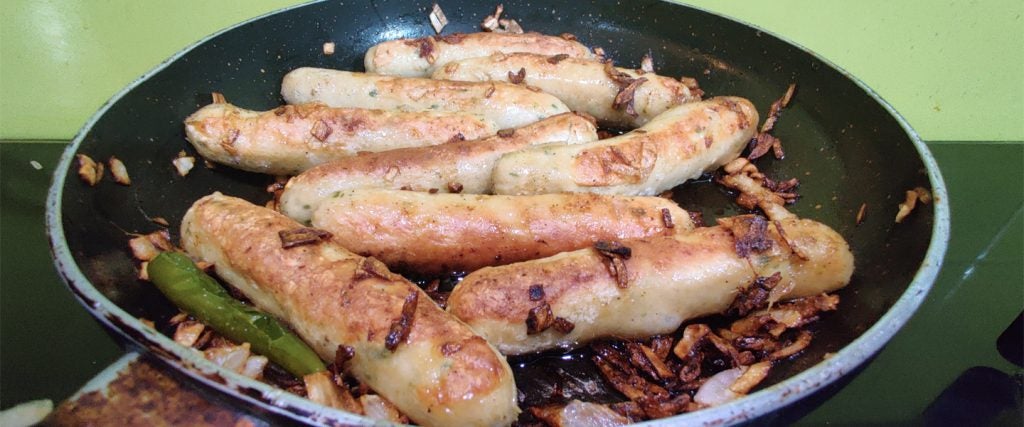What an age we live in, where all-meat chicken sausages are commonly available right alongside the pork and beef sausages of most grocery stores. It’s incredible to think that only 50 years ago, such a notion would have been thought of as ludicrous. It was in 1972 that the first modern, widely available chicken sausage emerged on the scene; it was a product of the Vineland Processing Company of New Jersey, and was sold in 16-ounce packages of six sausage patties bearing the “Poultry Pride” brand name.
Straight out of the gate, the frozen chicken sausage patties were advertised as being low in fat and high in protein, and capable of being cooked straight out of the freezer without any intermediary defrosting required.
Why was it so hard to create all-meat chicken sausages?
Some meats simply aren’t conducive to being prepared in non-obvious ways. In the same manner that turkey bacon took a long time to create — and wasn’t significantly healthier than pork bacon even after it emerged on the scene — sometimes the only way to give the new food source a presentation and texture similar to the food item being mimicked is to characteristically replicate the original food product. In the case of turkey bacon, this meant using the most fat-heavy portions of the turkey, like the dark meat and skin. In the case of chicken sausage, it often involves a similar process, or the re-addition and supplementation of additional fat sources later in the process after the chicken has been ground up.
That sounds like a lot of unnecessary work.
Au contraire!
By pre-20th-century standards, these processes for making an all-meat (or even mostly-meat) version of a chicken sausage are pure magic in their simplicity. An 1898 chicken sausage recipe advertised in the Kansas City Times necessitated the inclusion of bread crumbs, mushrooms, cream, eggs and a mosquito net. Don’t even ask what the mosquito net was for.
A little more than 10 years later, acceptable chicken sausage was so difficult to find that a writer for The Merchants Journal wrote that most “chicken sausage” included pork, veal, ox tongue, additional fat and just enough bits of chicken for the butcher to be able to advertise the presence of real chicken in the sausage, and then charge a premium for their “chicken sausage” product.
In light of this, please consider yourself fortunate that laws and innovations have evolved to such an extent that few butchers or brands are likely to exert the effort required to swindle you out of your hard-earned money in exchange for spurious chicken sausages.
It’s good to be living in the 21st century! But is chicken sausage healthy?
Basically, yes. Also, not at all. It all depends upon what you’re looking to acquire from the meal you include that chicken sausage in, and how many chicken sausages are included.
For the most part, half of the calories contained within chicken sausages will be derived from fat, and the other 50 percent are going to come from protein. Let’s assume you’re going to be on a daily dietary regimen that allows you to consume a minimum of 2,000 calories, which means there would be nothing at all wrong if you were to consume all four of the chicken sausages contained within a pack of Al Fresco’s as your morning breakfast.
By the time you’re done with those sausages, you’ve only consumed 440 calories, and you’ve added 52 grams of protein to your system. So far, so good. That’s the precise moment when you realize that you’ve also nearly maxed out your recommended daily allotments of sodium and cholesterol, and you’ll have to exercise a fastidious form of restraint in order to prevent yourself from going completely overboard.
Here’s the kicker: To extract a similar quantity of protein from your pork sausages, you’re going to end up consuming twice as many calories — 800 plus — while ingesting a similar amount of cholesterol and sodium in the process.
So the true takeaway is that a chicken sausage isn’t a fundamentally healthy way to eat your chicken, because the traits that coalesce to construct an acceptable sausage aren’t conducive to the creation of the healthiest forms of food. There’s always a healthier way to pound down meat than grinding it to bits and stuffing it inside of a hog casing. However, if ground meat trapped within a pigskin is something you absolutely must combat with a fork and knife on your breakfast plate, you can do far worse than to invite chicken to your early morning sausage party.

